-
Courses

Courses
Choosing a course is one of the most important decisions you'll ever make! View our courses and see what our students and lecturers have to say about the courses you are interested in at the links below.
-
University Life

University Life
Each year more than 4,000 choose University of Galway as their University of choice. Find out what life at University of Galway is all about here.
-
About University of Galway

About University of Galway
Since 1845, University of Galway has been sharing the highest quality teaching and research with Ireland and the world. Find out what makes our University so special – from our distinguished history to the latest news and campus developments.
-
Colleges & Schools

Colleges & Schools
University of Galway has earned international recognition as a research-led university with a commitment to top quality teaching across a range of key areas of expertise.
-
Research & Innovation

Research & Innovation
University of Galway’s vibrant research community take on some of the most pressing challenges of our times.
-
Business & Industry

Guiding Breakthrough Research at University of Galway
We explore and facilitate commercial opportunities for the research community at University of Galway, as well as facilitating industry partnership.
-
Alumni & Friends

Alumni & Friends
There are 128,000 University of Galway alumni worldwide. Stay connected to your alumni community! Join our social networks and update your details online.
-
Community Engagement

Community Engagement
At University of Galway, we believe that the best learning takes place when you apply what you learn in a real world context. That's why many of our courses include work placements or community projects.
Medical Device Design
Professor Mark Bruzzi is a Professor in Biomedical Engineering at the National University of Ireland Galway and is also the Director and co-founder of the BioInnovate Ireland medical device innovation programme. BioInnovate Ireland is a multidisciplinary programme focusing on medical device product development from clinical needs identification, market validation, prototype development and business planning. Mark also is supporting the development of a number of innovative medical technologies He has over 50 journal and conference publications, seven patent applications, 3 licensed technologies and serves as an advisor to several medical device start-ups.
- Publications
- BMERM
Professor Peter McHugh is Professor of Biomedical Engineering at NUI Galway. He holds a BE in Mechanical Engineering from UCG (1987), and an MSc (1990) and PhD (1992) in Mechanics of Solids from Brown University, Providence, USA. He joined NUI Galway in 1991, where he is currently the Established Professor of Biomedical Engineering and Dean of the College of Engineering and Informatics. He is Director of the Biomechanics Research Centre (BMEC). He has a significant publication record, with 137 refereed journal publications, 10 book chapters and over 300 conference publications. He has supervised to completion 24 PhD and 23 research masters students. He has generated over €11m in research funding from national, EU and industry sources, and has active research collaborations with international leaders in the field, spanning Europe and the USA. He has received numerous awards, including membership of the Royal Irish Academy, Ireland’s national academy for the sciences and humanities (2011), the Silver Medal of the Royal Academy of Medicine in Ireland (Section of Bioengineering) in 2011, the Presidential Nominee Fellowship of Engineers Ireland in (2009), and the Alexander von Humboldt Fellowship (1995). He currently holds the position of Secretary for Policy and International Relations of the Royal Irish Academy.
Professor Laoise McNamara is a Professor in Biomedical Engineering at the National University of Ireland Galway and the Program Director for the Masters in Biomedical Engineering (MSc). She holds a PhD in Biomedical Engineering from Trinity College Dublin and a 1st class Honours degree in Mechanical Engineering from NUI Galway. She completed Postdoctoral training at Mount Sinai School of Medicine, New York, USA. From 2007-2009 she was a Lecturer in Mechanobiology and Musculoskeletal Biomechanics at the University of Southampton, United Kingdom. She was appointed to NUI Galway in 2009 as a Science Foundation Stokes Lecturer in Biomedical Engineering. She established the Mechanobiology and Medical Device Research group (MMDRG, www.mechanobiology.ie) at NUI Galway. Her research has been widely published and cited, and has attracted significant research funding (€3,620,285), most notably the ERC Starting Independent Researcher Award (€1,499,910) in 2011 and a Science Foundation Ireland Investigators Grant (€883,257). She has interdisciplinary research collaborations with researchers at Georgia Tech, Notre Dame University, City College of New York, Worcester Polytechnic Institute, Tampere University of Technology, INSERM Nantes and the University of Southampton. She collaborates with Stryker, Boston Scientific and Medtronic.
Dr. Ted Vaughan is a Lecturer in Biomedical Engineering. His research focusses on development of multiscale modelling techniques to address problems in biomechanics, mechanobiology, medical device design and composite materials. He graduated with a First Class Honours Degree in Mechanical Engineering from the University of Limerick in 2007. He was awarded a PhD in Mechanical Engineering in 2011, also from the University of Limerick, for research in the area of computational micromechanics of composite materials. Between 2011-2015, he held a position as a postdoctoral researcher in the Centre for Biomechanics Research (BMEC) here at NUI Galway. During this time, he also held a position as a Visiting Postdoctoral Scholar at the University of Notre Dame, funded through a Postdoctoral Mobility Grant awarded by the Royal Irish Academy. To date, Dr. Vaughan has published approximately thirty peer-reviewed journal articles in internationally-respected journals in the fields of multiscale modelling, computational biomechanics and medical device design. One of these articles is listed as one of the Top-10 most cited articles published in Composites Science and Technology over the past five-years (currently the leading journal in the field of composite materials). He actively collaborates with a range of Industry partners, including Proxy Biomedical, Meotec Gmbh, Boston Scientific and Stryker.
Professor Mark Bruzzi
Prof. Mark Bruzzi’s research focusses on the design and development of novel medical devices that meet under-met and unmet clinical needs. Of specific interest is the interaction between the device and the human anatomy and pathophysiology. The example below focusses on Peripheral arterial disease (PAD) which is a very common vascular condition affecting miliions of people worldwide. This project focusses on the femoropopliteal artery which often requires treatment by percutaneous transluminal angioplasty followed by stenting to restore vessel patency and blood flow. The Surrounding muscles interact with the underlying blood vessels during movement of hip and knee flexion and extension. As a result, various deformations of the femoropopliteal vessel, due to its interaction with closely surrounding muscle groups are translated to the vessel. Together, this in vivo deformation and loading leads to compression, bending and torsion of the vessel leading to a complex and challenging biomechanical environment for stent devices used to treat PAD.
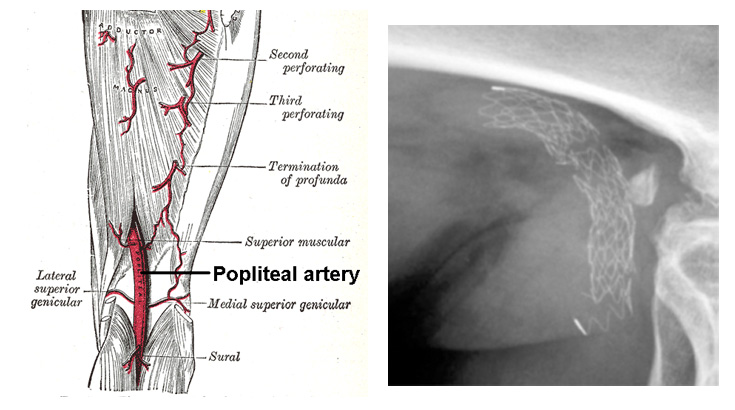
The project aimed to advance the understanding of the deformation and in vivo loading characteristics of the stented femoropopliteal artery. A finite element model of the unstented femoropopliteal artery, surrounded by the anatomically accurate muscle groups was used to determine worst locations for stent placement in the SFA. This was then experimentally investigated in a cadaver study. This allowed the deformation characteristics of the unstented and stented femoropopliteal artery to be realised from which the change to deformation sue to various stent placements were established.

Professor Peter McHugh
This animation illustrates the solution of the complex non-linear multi-body problem of angioplasty balloon inflation and coronary stent deployment, using the Abaqus finite element software, and run on the Irish Centre for High End Computing (ICHEC) computing resources. It clearly illustrates the outstanding and world class computational modelling capabilities of the BioMEC researchers at NUI Galway.
This animation comes from the work published in Grogan, J.A., Leen, S.B. and McHugh, P.E., “Optimizing the design of a bioabsorbable metal stent using computer simulation methods”, Biomaterials, Vol. 34, No. 33, pp. 8049-8060, 2013.
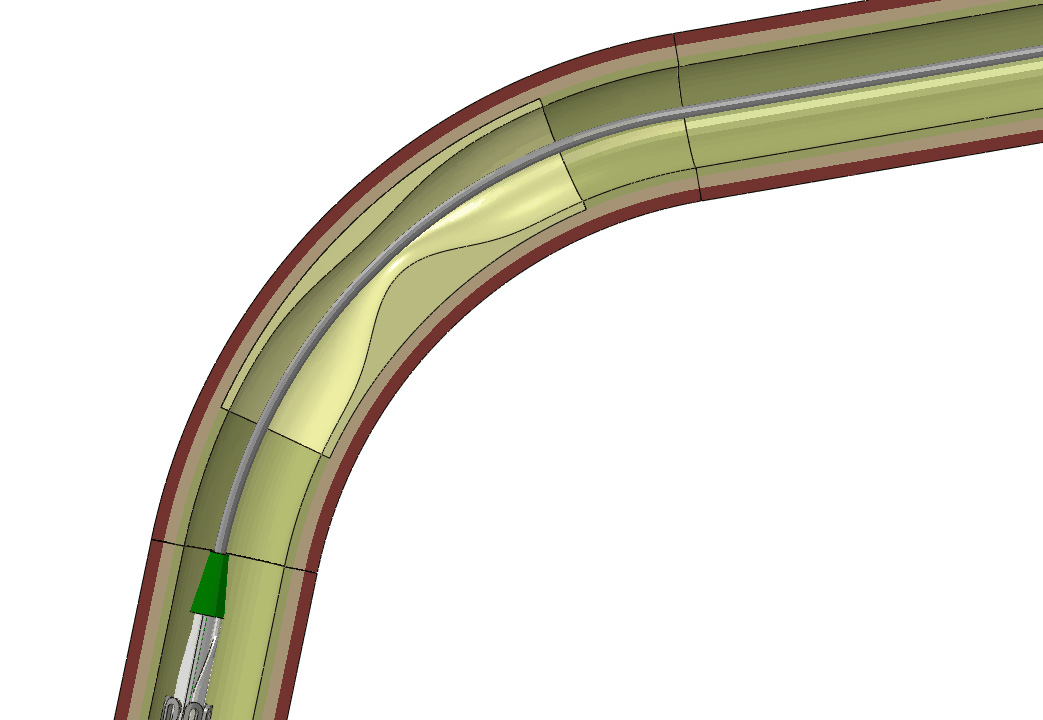
Building on the BioMEC world-class computational modelling capabilities this animation illustrates the simulation of the biodegradation of a magnesium stent deployed in a coronary artery. The simulation incorporates the utilisation of the ground-breaking “pitting-corrosion” model developed at NUI Galway that captures the non-uniform degradation patterns of metals in a corrosive environment in a highly realistic way. This model allows for the biomechancial performance of the biodegradable stent to be simulated, as part of an overall biodegradable stent design and performance assessment framework.
This animation comes from the work published in Grogan, J.A., O’Brien, B.J., Leen, S.B. and McHugh, P.E., “A corrosion model for bioabsorbable metallic stents”, Acta Biomaterialia, Vol. 7, No. 9, pp. 3523-3533, 2011.

Professor Laoise McNamara
Conventional design and development efforts for medical devices largely focus on establishing the biocompatibility and mechanical stability of materials. Although computational models are widely used to predict device performance for regulatory purposes, these models largely neglect the complex multi-physics environment, which is dictated by the interaction between biological cells and tissues with body fluids.
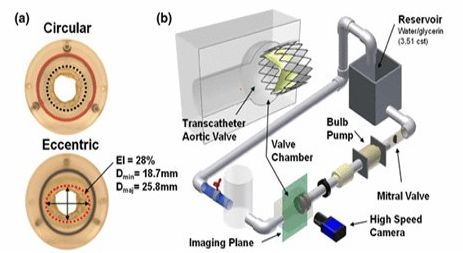
Furthermore cells and tissues respond to biophysical stimuli imposed by medical devices and these responses are fundamental to long-term performance, but remain poorly understood. As a result the ability to control such responses through innovative device design has not yet been fully harnessed. Prof. McNamara’s research group have provided computational approaches that can simulate interactions between deformable biological structures, adjacent fluid flows and medical devices. Her group collaborate with medical device partners (Boston Scientific, Stryker Instruments, Medtronic) to apply their computational methods to understand the design of next generation medical devices. They also collaborate with companies to provide fundamental understanding of the response of bone cells to the physical environment imposed by medical devices.
Dr. Ted Vaughan
Dr Ted Vaughan has developed multiscale models of mineralised tissue behaviour in the elastic regime, whereby a Representative Volume Element (RVE) model is used to represent mineral and collagen phases discretely. Using a computational homogenisation approach, this model can predicted how both the relative volume fraction and structural arrangement of mineral crystals at the nano-scale contribute to tissue-level mechanical properties.

Dr Ted Vaughan has developed predictive finite element models of the the surgical cutting process in trabecular bone tissue and bone analogue materials. Shown here is a simulation of drilling into a polyurethane bone analogue material, whose consitutive behaviour is described by a Johnson-Cook elastic-plastic damage model. These models are providing insight into the role of various cutting parameters (e.g. tool geometry, feed rate) influence overall cutting performance, in terms of cutting force and chip formation.
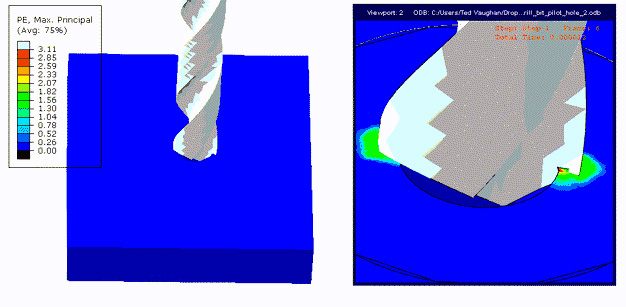








 Professor Mark Bruzzi
Professor Mark Bruzzi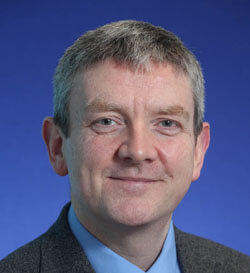 Professor Peter McHugh
Professor Peter McHugh Professor Laoise McNamara
Professor Laoise McNamara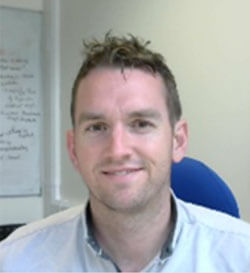 Dr. Ted Vaughan
Dr. Ted Vaughan






